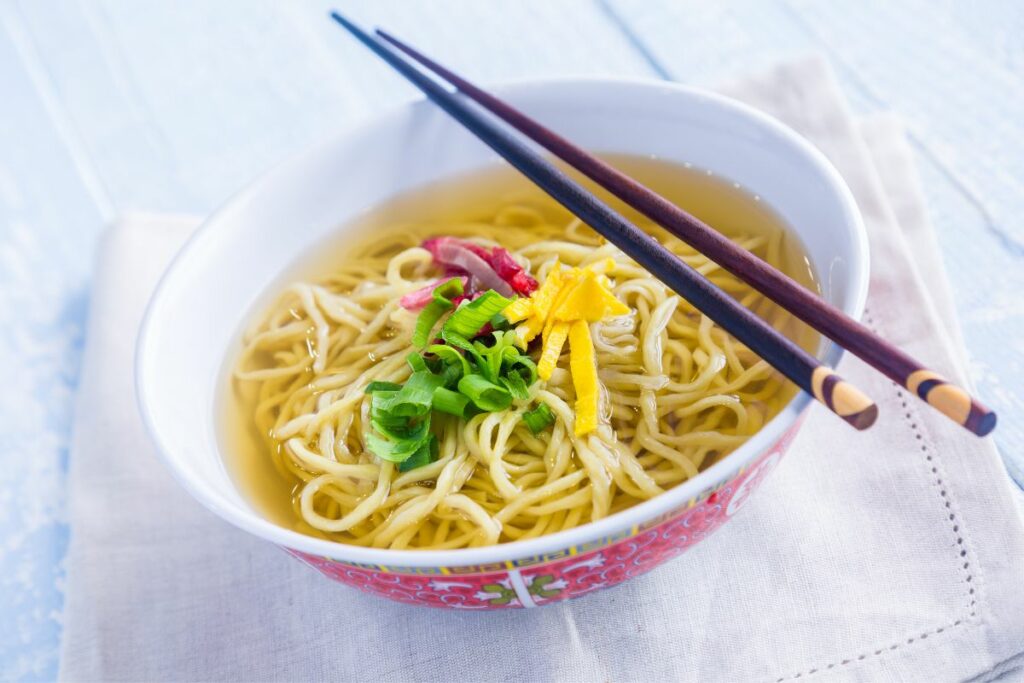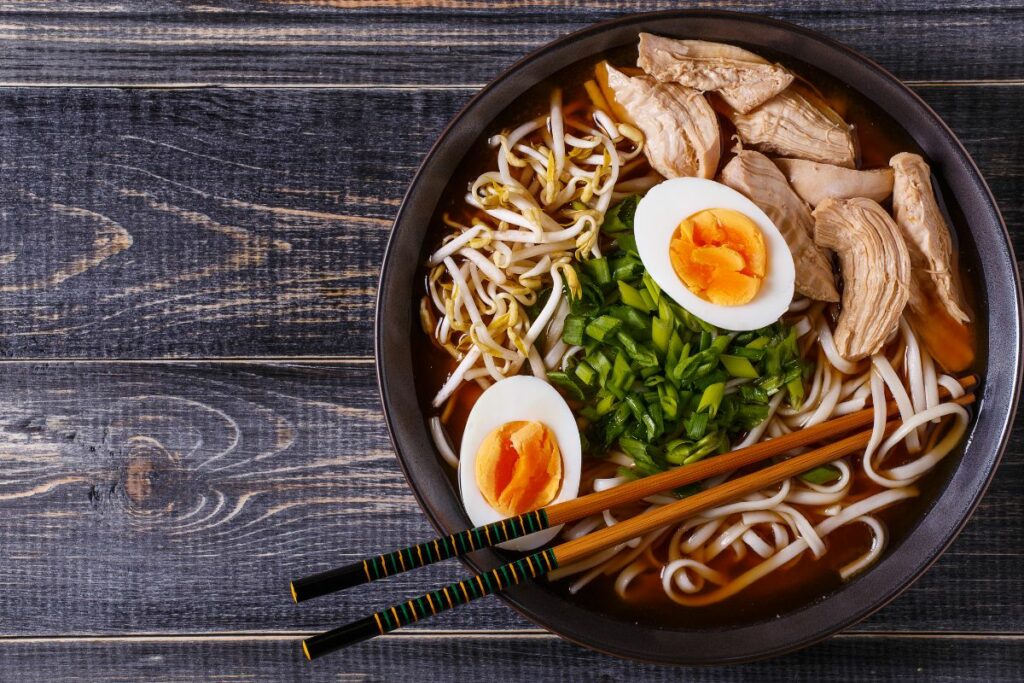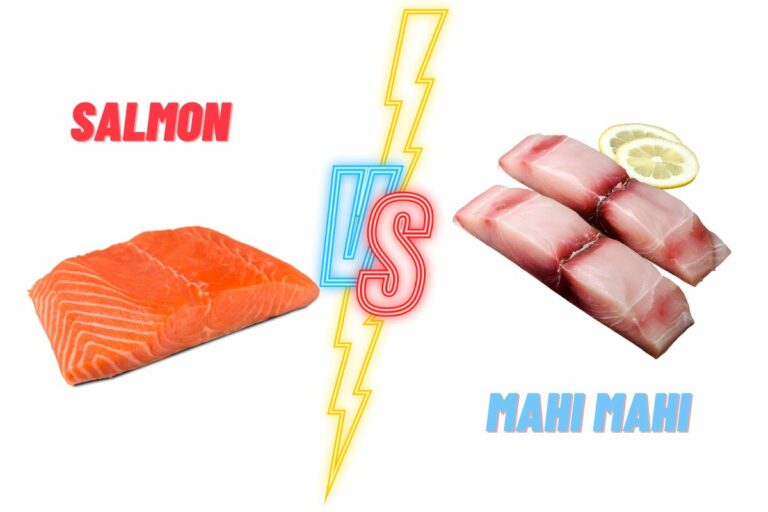Saimin VS Ramen
Saimin and Ramen are two popular noodle dishes that originated in different parts of the world.
Saimin is a Hawaiian noodle dish that is made with wheat-based noodles in a broth made from a mixture of dashi, and other ingredients, and is typically topped with ingredients like green onions, sliced meats, and kamaboko (fish cake). Ramen is a noodle dish of the Japanese made in the style of Chinese wheat noodles served in a meat or fish-based broth. Often flavored with soy sauce or miso, and topped with ingredients like sliced pork, dried seaweed, and boiled eggs.
While both dishes are made with wheat-based noodles and served in a broth, the differences in the broth, toppings and cultural significance set Saimin and Ramen apart.
We know that you want to know more about Saimin and Ramen, well worry not because we have made an entire article for you based on this topic.
What Is Saimin?

Saimin is a beloved noodle soup dish that is a staple in Hawaiian cuisine. It has a unique history that stems from the island’s diverse cultural influences. Saimin is a fusion of Chinese and Japanese culinary traditions, and it has become an iconic dish in Hawaii.
The dish’s origins can be traced back to the early 1900s when immigrant workers from China and Japan introduced their traditional noodle soups to Hawaii’s multicultural communities.
- Saimin is typically made with thin wheat noodles that are served in a savory broth made from chicken, pork, and/or fish.
- The broth is flavored with soy sauce, green onions, and other seasonings, which gives it a distinct umami flavor.
- The dish can be enjoyed with a variety of toppings, including char siu pork, kamaboko (fish cake), boiled eggs, and vegetables.
- It is often served in a large bowl, and it is a comforting and satisfying meal that is perfect for any time of the day.
Saimin has become a cultural icon in Hawaii, and it can be found in many local restaurants, diners, and fast-food chains. It is a reflection of the diverse and rich culinary history of the Hawaiian Islands, and it continues to be a popular dish that locals and tourists alike can enjoy.
What Is Ramen?

Ramen is a popular Japanese dish that consists of Chinese-style wheat noodles served in a savory broth. It is a dish that has become a culinary icon in Japan and has gained worldwide popularity due to its unique flavor and comforting qualities. Ramen is believed to have originated in China, but it was brought to Japan by Chinese immigrants in the late 19th century.
- The noodles used in ramen can vary in thickness and texture, and they are typically served in a broth that is flavored with soy sauce, miso, or salt.
- The broth is often made with meat or fish stock and can be garnished with a variety of ingredients, such as sliced pork, nori (dried seaweed), green onions, and bamboo shoots.
- There are many different styles of ramen, each with its own unique flavor profiles and toppings.
- Ramen has become a culinary phenomenon, with ramen shops and chains popping up all over the world. It is a comforting and satisfying meal that is perfect for any time of the day, and it is often enjoyed as a quick and easy lunch or dinner.
The popularity of ramen has even led to ramen festivals and competitions, where chefs compete to create the most delicious and creative versions of this beloved dish.
Saimin VS Ramen – At A Glance
Let’s have a quick look at the table before we get into the details of the differences between saimin and ramen
| Difference | Saimin | Ramen |
| Taste | Savory | Umami |
| Texture | Chewy | Slippery |
| Color | Orange | Brown |
| Cooking | 2-3 minutes | 3-6 minutes |
Key Differences Between Saimin and Ramen
We have gathered a few key differences for you to decipher the various aspects of Saimin and Ramen. They are as follows:
Taste
The key differences in taste between saimin and ramen lie in their broth and seasoning.
- Saimin broth typically has a lighter and milder flavor compared to ramen broth, which tends to be richer and more robust.
- Saimin broth is usually made with a combination of chicken, pork, and/or fish stock, and flavored with soy sauce, green onions, and other seasonings.
- In contrast, ramen broth can vary widely in flavor, ranging from soy sauce-based Shoyu to miso-based or salt-based broths, and often include a combination of meats and/or seafood, vegetables, and aromatic spices.
Similarly, the seasoning in saimin tends to be more subtle and simple, with a focus on the natural flavor of the ingredients, whereas ramen seasoning is more complex and bold, with the use of umami-rich ingredients like miso, soy sauce, and bonito flakes.
Additionally, saimin toppings typically include sliced char siu pork, kamaboko, and boiled eggs, while ramen toppings may include additional ingredients like bean sprouts, corn, and mushrooms.
Overall, while both saimin and ramen are delicious noodle soups, the differences in their broth and seasoning give them distinct flavor profiles that cater to different taste preferences.
Texture
The key differences in texture between saimin and ramen are primarily in the noodles.
- Saimin noodles are usually thinner and straighter compared to ramen noodles, which can vary in thickness and texture.
- Saimin noodles are typically made from wheat flour and have a more delicate texture, similar to Chinese egg noodles, while ramen noodles can have a chewier texture and may be made with alkaline water or Kansui, a type of mineral water that gives the noodles their characteristic springy texture.
- In addition to the differences in noodle texture, the overall texture of the soup can also vary.
- Saimin broth is typically lighter and less viscous compared to ramen broth, which can be thicker and more gelatinous due to the use of collagen-rich meat bones and/or seaweed.
- Saimin also tends to have simpler toppings, with fewer ingredients contributing to the overall texture, while ramen can have a more complex texture with the addition of various vegetables, meats, and toppings.
In conclusion, the differences in texture between saimin and ramen are subtle but can contribute to different overall dining experiences, with saimin offering a delicate and comforting soup, while ramen provides a heartier and more robust dish with chewier noodles and a thicker broth.
Cooking Time
The key differences in cooking time between saimin and ramen are primarily in the preparation of the broth and the noodles.
- Saimin broth is typically simmered for a shorter time compared to ramen broth, resulting in a lighter and more delicate flavor.
- The broth may be made by combining chicken, pork, and/or fish stock with soy sauce, green onions, and other seasonings, and then simmering for around 30 minutes to an hour.
- Ramen broth, on the other hand, can be simmered for many hours to extract maximum flavor from the meat and bones used to make it.
- Depending on the specific type of ramen, the broth may be made using chicken, pork, beef, or seafood, and may also include ingredients like miso paste or soy sauce. The longer cooking time allows for a richer and more complex flavor profile.
The cooking time for the noodles also varies between saimin and ramen. Saimin noodles are typically boiled in water until they are just cooked through, which usually takes 2-3 minutes. Ramen noodles, on the other hand, can take anywhere from 3 to 6 minutes to cook, depending on the specific type and texture.
While the cooking times for saimin and ramen vary slightly, the key difference is in the preparation of the broth, with saimin typically requiring less cooking time for a lighter and more delicate flavor, and ramen requiring a longer cooking time for a richer and more complex flavor profile.
Availability
The key differences in availability between saimin and ramen depend largely on the location and cultural context.
- Saimin is a traditional Hawaiian dish that has its roots in the plantation era of Hawaii, where a mix of Asian immigrants brought their culinary traditions with them.
- As a result, saimin is most commonly found in Hawaii, particularly in local restaurants, diners, and food trucks.
However, it is relatively less well-known outside of Hawaii and may be more difficult to find in other parts of the world.
- Ramen, on the other hand, is a Japanese dish that has gained widespread popularity and availability around the world, particularly in major cities.
- Many Japanese restaurants and chains, as well as non-Japanese restaurants, serve ramen as a menu item.
Instant ramen is also widely available in grocery stores and online, making it an accessible and convenient food option for many people.
In recent years, saimin has gained some popularity outside of Hawaii, particularly among those interested in exploring diverse and lesser-known culinary traditions. However, it remains relatively less available compared to ramen, which has become a more mainstream and widely-known dish.
The availability of saimin and ramen depends largely on the cultural context and location, with ramen being more widely available globally, while saimin is primarily found in Hawaii and may be less well-known outside of that region.
Saimin VS Ramen – Nutrition Facts and Health Benefits
Here is the nutrition table for Saimin and Ramen.
| Nutritious Element | Saimin | Ramen |
| Calories | 220 | 280 |
| Fat | 4g | 9g |
| Carbohydrates | 37g | 38g |
| Protein | 8g | 8g |
| Sodium | 790mg | 1000mg |
While saimin and ramen are both delicious and satisfying dishes, they are generally not considered to be particularly nutritious foods. Both saimin and ramen are high in carbohydrates and sodium, and may also contain high levels of fat depending on the specific ingredients and cooking methods used.
That being said, some of the ingredients used in saimin and ramen may offer some potential health benefits when consumed in moderation.
For example, both dishes typically include vegetables such as green onions, which are a good source of vitamins and minerals. Additionally, some types of ramen may include seaweed, which is rich in iodine, and mushrooms, which are a good source of antioxidants.
Can You Substitute Saimin For Ramen?
While saimin and ramen are both noodle dishes, they have some key differences in terms of flavor, texture, and preparation. As such, it may not be the best idea to substitute saimin for ramen or vice versa if you are looking for a specific flavor or texture profile.
- Saimin noodles are typically thinner and softer compared to ramen noodles, and the broth has a lighter, more delicate flavor.
- Saimin broth is also often made with a blend of chicken, pork, and/or fish stock, while ramen broth is typically made with one specific type of meat or seafood and may also include additional ingredients like miso paste or soy sauce.
If you are unable to find one of these dishes and are looking for a substitute, you could try other types of noodle soups that have similar flavor profiles, such as udon or soba noodles.
Alternatively, you could try making your own version of the dish at home using similar ingredients and flavors to achieve the desired taste and texture. However, keep in mind that the resulting dish may not be exactly the same as the original dish.
The Future of Saimin and Ramen in Modern Cuisine
Saimin and ramen have both gained widespread popularity and recognition in modern cuisine in recent years. As consumers continue to seek out new and diverse culinary experiences, these dishes are likely to remain relevant and evolve alongside changing tastes and trends.
- In particular, we may see an increased emphasis on healthier, more nutritious versions of these dishes that incorporate fresh, locally sourced ingredients and alternative ingredients like whole grain noodles or plant-based proteins.
- Chefs and restaurateurs may also experiment with different broths and flavor combinations to create new and unique takes on these classic dishes.
- Additionally, we may see an increased focus on the cultural and historical significance of these dishes, as chefs and food writers seek to highlight the rich cultural traditions and influences that have shaped saimin and ramen.
- This could include a greater emphasis on regional variations and lesser-known variations of these dishes, as well as efforts to preserve and celebrate their historical and cultural roots.
Overall, saimin and ramen are likely to continue to play an important role in modern cuisine, as consumers seek out new and exciting flavors and experiences, and as chefs and restaurateurs experiment with new ways to bring these classic dishes to life.
Storage Tips for Saimin and Ramen
To store saimin and ramen noodles properly, it’s important to ensure that they are kept dry and away from moisture. Here are some storage tips:
- Store dry noodles in a cool, dry place: Keep saimin and ramen noodles in their original packaging or transfer them to an airtight container. Keep them away from heat sources and in a cool, dry location.
- Keep fresh noodles refrigerated: If you have fresh saimin or ramen noodles, they should be kept refrigerated in an airtight container. Use them within a few days for best quality.
- Store cooked noodles separately: If you’ve already cooked your saimin or ramen noodles, store them separately from the broth and other ingredients. For up to three days, keep them in the refrigerator in an airtight container.
- Freeze for long-term storage: If you need to store saimin or ramen noodles for a longer period, you can freeze them. The noodles must first be cooked, drained, and cooled before freezing. Place the noodles in an airtight container or freezer bag and freeze for up to three months.
Remember to always follow safe food handling practices and be mindful of food safety when storing and reheating leftovers. Discard any food that appears or smells spoiled.
FAQs
What are the different types of Ramen?
There are many different types of ramen, each with its own regional and flavor variations. Some popular types include Shoyu (soy sauce-based), miso (soybean paste-based), Shio (salt-based), and tonkatsu (pork bone-based) ramen.
What is the best way to enjoy Saimin?
The best way to enjoy saimin is to first savor the clear, light broth before mixing in the toppings and noodles. Many people like to add condiments like soy sauce, sesame oil, or chili paste to enhance the flavor according to their preferences.
How do you eat Ramen?
Traditionally, Ramen is eaten by using chopsticks to pick up the noodles and other toppings and then slurping the soup directly from the bowl.
Wrapping Up
In conclusion, while saimin and ramen may appear similar, they are distinct in terms of their origin, ingredients, and preparation methods. Saimin is a traditional Hawaiian dish with Chinese, Japanese, and Filipino influences, featuring a light broth and simple toppings, while ramen is a popular Japanese noodle soup with a variety of regional and flavor variations, often featuring rich, fatty toppings.
Ultimately, the choice between the two depends on personal taste and preferences, but with a little creativity and experimentation, both dishes can be enjoyed in a healthy and delicious way.
Whether you are looking for a quick and satisfying meal or an authentic culinary experience, saimin and ramen are both worthy contenders to add to your menu.



